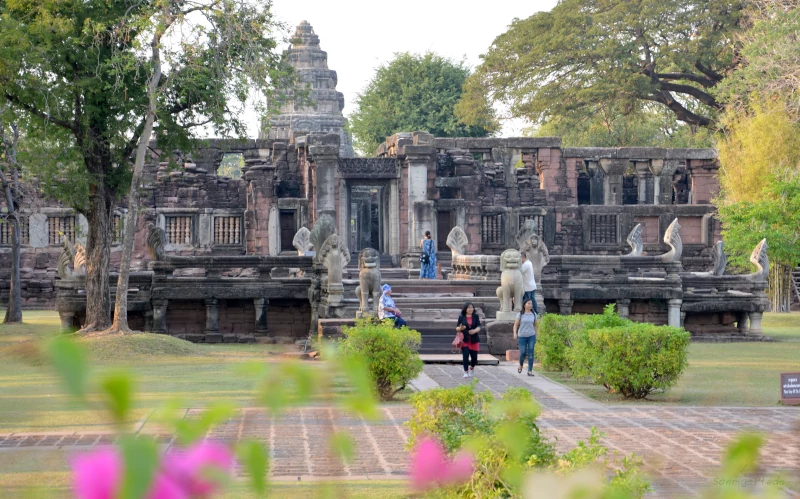
The town is small, the atmosphere is quiet, the landscape is characterized by the loops of the Moon – River. But in Phimai there are special testimonies of history in Southeast Asia, which is why a visit there is recommended. Settled already since the Neolithic Age, Phimai had its greatest time as a western border town of the Khmer – Empire about the 9th to 13th century. Today, the temple ruins of Phimai are the most important remains of the Khmer Kingdom in Thailand.
Ruins in the Isarn Upland – the Phimai Temple Complex
Phimai is located in Thailand about 60km northeast of Nakhon Ratchasima (Khorat) on the Moon River. Already when arriving by bus, we first pass the temple ruins, which today form the „Phimai Historical Park“. Then the bus stops at the clock tower, which is the most prominent „landmark“ in the center of Phimai. To the left, the area is quite open and wide – there is space for the night market here and there is a ruined building on a hill, of which it is hardly recognizable what purpose it may have once served.
On the right, by contrast, along the main street is a closed neighborhood with stores and residential development behind. Back to the intersection, the cross street left and into a somewhat hidden narrow alley, there I find my small, set back and therefore very quiet guesthouse. A bright, clean and comfortably furnished room with shower bath – pleasant conditions for the stay in Phimai. On the shady terrace in front of the house sit a few other travelers, some exchange about their explorations or scribble in diaries, one plays quite well on the guitar. I immediately go on a first exploration tour.
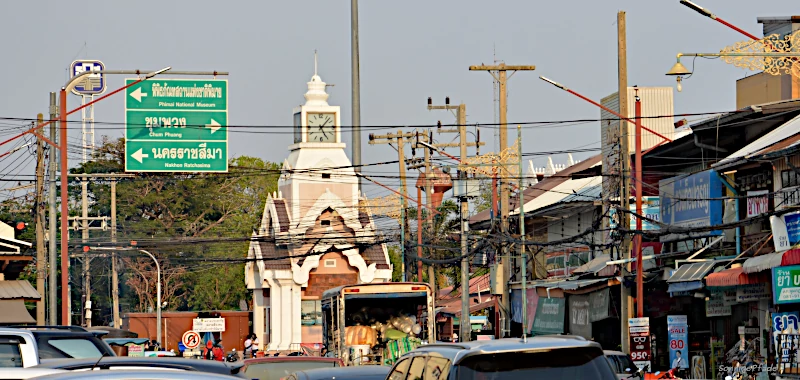
Stone formations in the evening light
The temple complex is located in the northwestern quadrant of the streets branching off from the clock tower intersection. Can you really say so – the streets are largely as if drawn with a ruler. Probably always so, because the temple complex is also rectilinear and rectangular. After a lemonsoda, as I like it – cool sparkling water from a deposit glas bottle and fresh lemon slices – I go around the temple ruins from the outside. I save the sightseeing for the next day, because I want to have more time for it. Already now, in the low evening sun with strong warm light I am quite impressed by the ruins. Especially when I consider that these are already around 1000 years old. Inside I see teenage Thai climbing around in the corridors and at window holes – probably a school trip with history lessons.
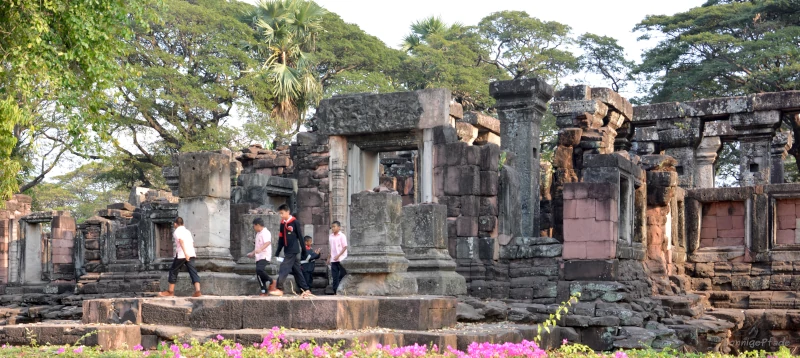
The concentric layout of the temple district is recognizable. Gate buildings are exactly in line with the sanctuary in the center, so that visual axes run directly to this conical tower. Corridors of the inner buildings are also strictly rectilinear. The southern axis can easily be extended to the „Pratu Chai“, the victory gate. It is said that Phimai was connected with the capital of the Khmer Empire in Angkor Wat by a 225km long road.
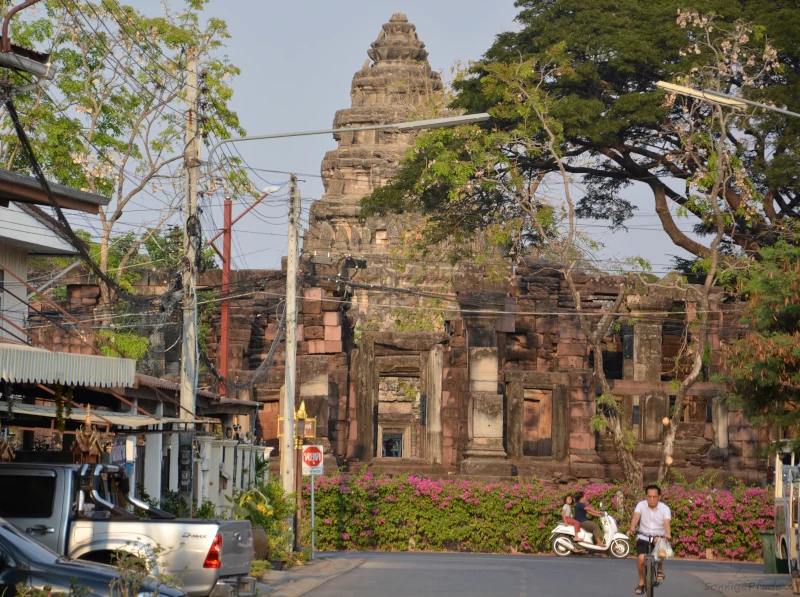
The historical temples of Phimai
Around the 10th century, probably under Khmer King Jayavarman VI, the temples of Phimai were built as a spiritual center of the Khmer Empire of Angkor. Moreover, Phimai was an important border town even before the neighboring kingdom of Siam could strengthen and assert itself. In the eleventh century under King Jayavarman VII, the town of Phimai was fortified. Its location in a bend of the Moon River favored its defensive capability from the beginning. Along with the temples, a city named Vimai or Vimayapura was built. City walls and gates to the west, north and south (the Pratu Chai gate) surrounded the entire settlement. The fortification to the east may have fallen victim to the Moon floods over time. Historians explain the slight deviation to the southeast of the whole complex with the exact alignment to Angkor Wat.
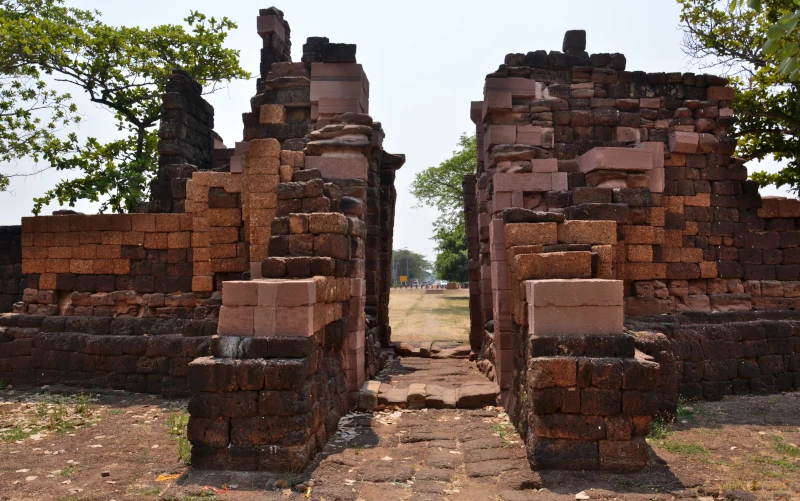
The temple of Phimai itself was „rediscovered“ since the beginning of the 20th century and became protected in the 1930s. Restoration work has been underway since the 1950s. The Phimai History Park was created, for which an entrance fee is charged.
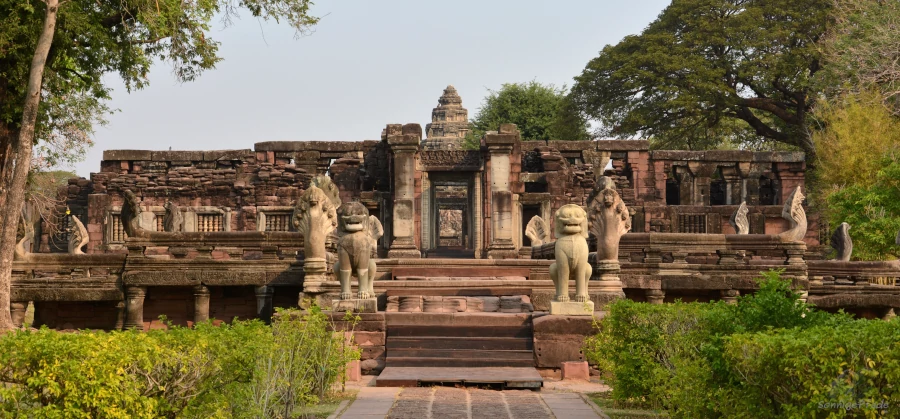
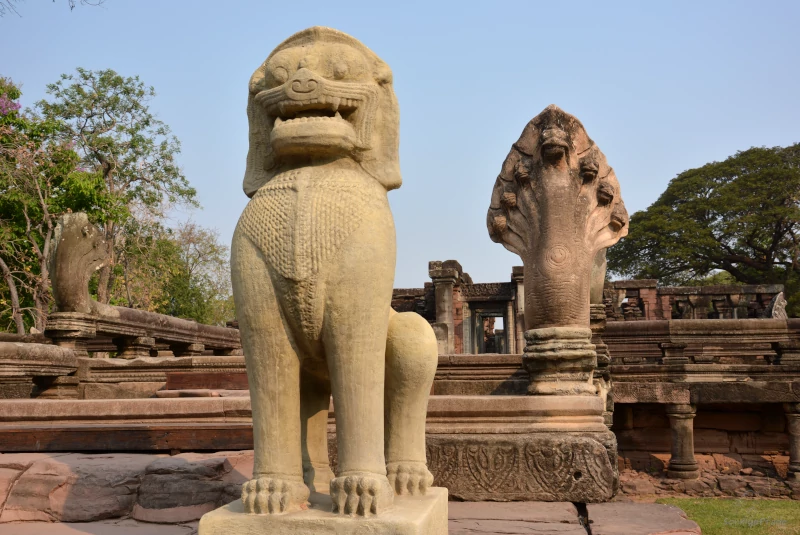
In the innermost center of the Phimai temple
The temple interior is surrounded by walls of red sandstone. Already the play of colors with red, yellowish and white stones make the complex look very lively. To get to the most sacred part, the 28m high tower, one has to cross several rings of walls and buildings, which form rectangles. In between are large open spaces, some with embedded water basins. There is a statue of King Jayavarman VII in the Prang Bramadhat. In many places you can see well preserved very detailed stone carvings. Very pleasant is the alternation of open views, narrow stone corridors and areas overshadowed by trees, so that the visit does not become an ordeal despite the southeast Asian heat.
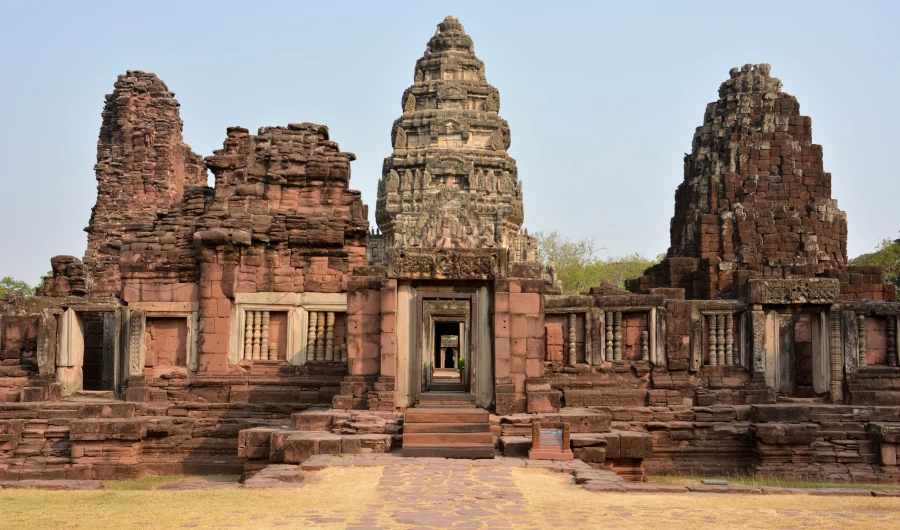

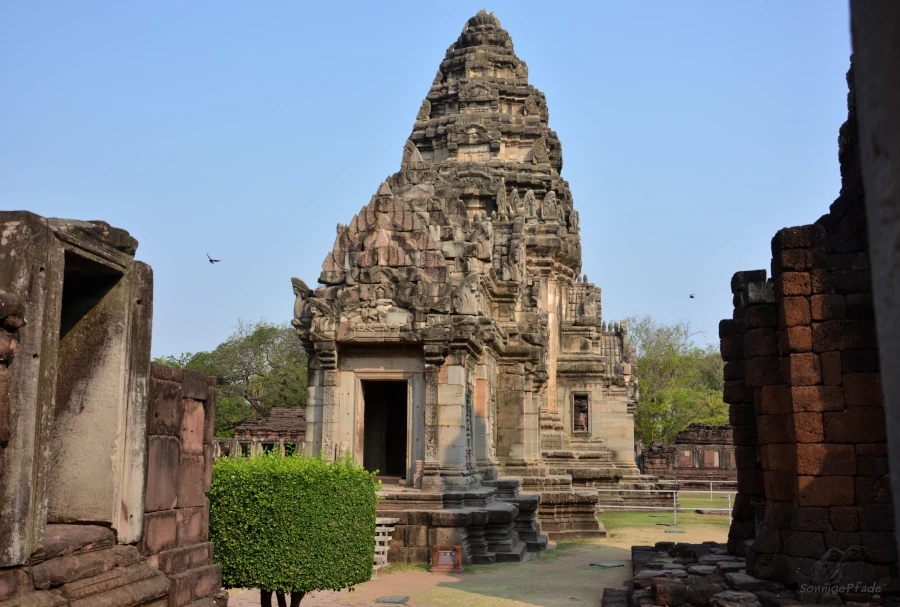
The Phimai National Museum
A Phimai National Museum complements the original witnesses of the outdoor sites with exhibits such as Buddha statues, carved door lintels and sculptures, which should not be further exposed to the weather or were collected from the wider surroundings of Phimai. The museum is located outside the history park on the road to Nakhon Ratchasima just before the Tha Songkhram bridge over the Moon.

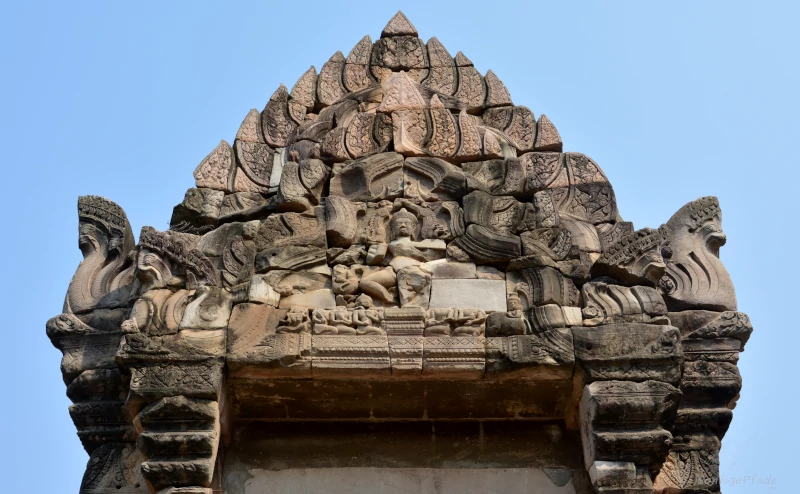
The biggest Banyan – tree of Thailand
A bicycle is not a bad thing in Phimai. Some accommodations also offer them. Then you can go out a little along the loops of the Moon River. Northeast of the city center you will find on the island Sat Ngam in the Moon probably the oldest and largest sacred Banyan tree (Ficus benghalensis) of Thailand. It is said to be about 350 years old. The crown stretches almost over the whole island with a diameter of 85m. It is a pleasant joy to stroll in the shade of the tree crown among the tangle of aerial roots and look down on the pond-like river bends where fat carp fish wait to be fed by the locals. Many Thai take advantage of the picnic areas under the tree, some also seek out the hidden prayer spots or offer to predict your fate from your palm lines.
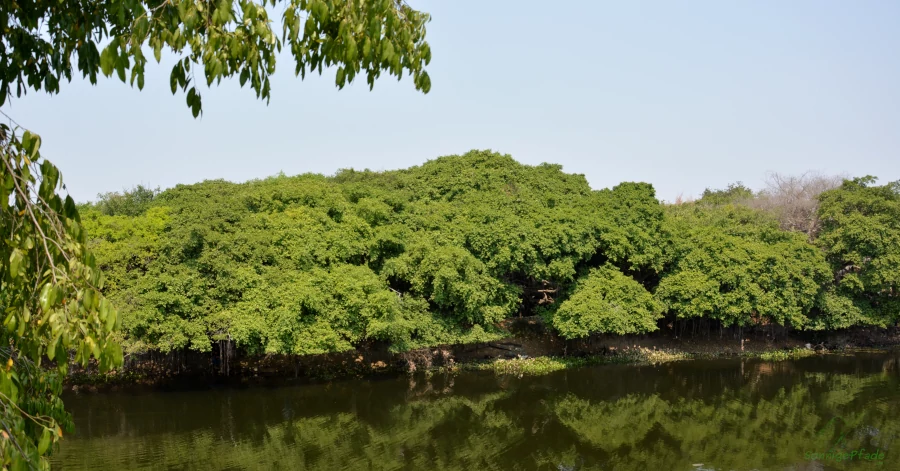
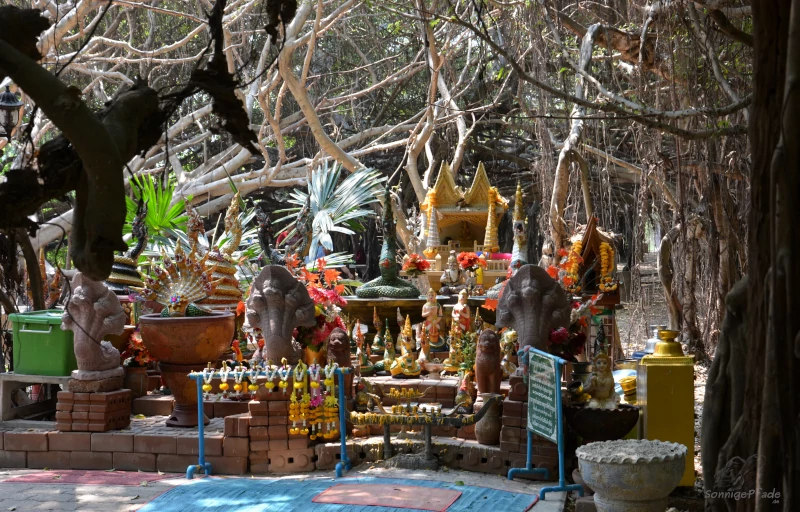
Night market and aerobics
Like almost everywhere in Thailand, there is also a night market in Phimai. Strolling there in the evening is quite pleasant, especially since there is not quite as much of a crowd as in some big cities. On the big square at the clock tower you may encounter the Thai version of aerobics (or as the dance gymnastics is currently called in the western hemisphere) – publicly performed by dozens of movement enthusiasts.
[Contains *advertising]
Getting to Phimai
The small town of Phimai in the Korat Plain can be reached by bus from Nakhon Ratchasima (Khorat), there from the new bus terminal 2 on Highway 2. Buses run very frequently during the day*, up to half-hourly. It is about 60km, for which the buses need about 1 1/4 hour.
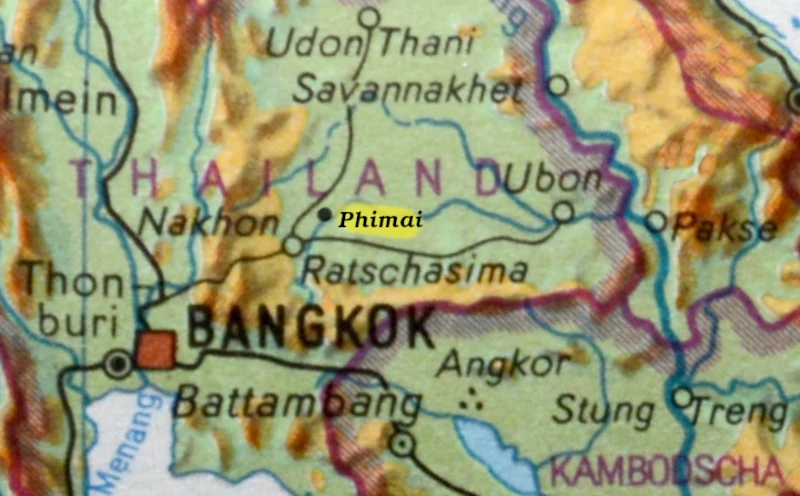

From the bus terminal in Khorat you can go directly to Bangkok, Nong Khai, Chiang Mai and other Thai cities. In Phimai it is best to get off the bus at the clock tower – there you are right in the center. For the return trip you can also wait there for a bus in the opposite direction (pay attention to left-hand traffic!).
Accommodation in Phimai – Hotels and Guesthouses
The Benya Guest House* is located near the entrance to the Historical Park in Phimai. Small cozy rooms with decent shower bathrooms and freely available bicycles make the stay very comfortable and uncomplicated. The manager speaks good English and is very concerned about the well-being of her guests. Travellers like to meet on the terrace in front of the house and exchange their experiences and tips.
At Moon River Resort*, guests can enjoy the river scenery. Accommodation is offered in several different air-conditioned bungalows with modern facilities. The evening can be spent in peace on a terrace. Breakfast is offered. Bicycles are available to guests free of charge. If the water conditions are suitable, there is even the possibility to swim in the Moon River at a private river beach. The Phimai Historical Park is about 10 minutes walk away. Wellness offers like massages are arranged.
Rabbit Hotel Phimai* offers air-conditioned double and triple rooms for its guests. The rooms have private bathrooms, desks and refrigerators. From the historical park, Rabbit Hotel is about 1km away.
Baan Lita Hotel* is quietly located just outside and about 1.3km from the temple complexes of Phimai. With well-appointed air-conditioned rooms feature en suite bathrooms, refrigerators and desks. These hotel complex also includes a terrace and garden. The well-kept complex is one of the best – rated in Phimai.
The current weather in Phimai
How the weather is today in Phimai and the outlook for the next three days is illustrated by the small overview on the left.
Phimai Literature
Helpful tourist guides you can find in the Thailand north travel tip post.
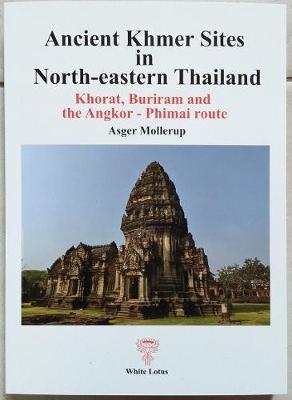
If you want to dive deeper in the ancient Khmer culture, especialli in Thailands north east, I recomend you the Book “Khmer sites in north eastern thailand“* by Asger Mollerup.
Interested in the temples of Phimai? Invite your friends!
If you liked this post, share the link here in your social media channels! A good response helps to separate useful posts from data garbage in search engines and generate better search results.
* Note on advertising links
The links marked with * refer to booking platforms or online stores. If you order something through such a link, the „Sunny Paths“ blog get a small commission, which helps to compensate the effort of these sites. For you nothing will be more expensive, because the commissions are already taken into account in the pricing of the providers.

